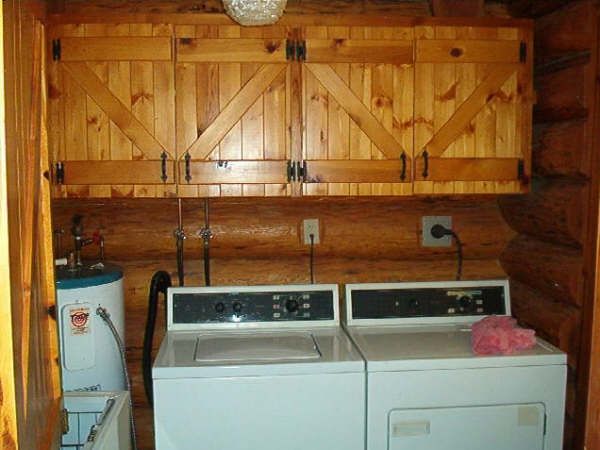Stile and Rail Sizes for Doors and Drawer Faces
A thoughtful discussion on whether and how to vary the stile and rail proportions when designing and detailing cabinets with larger doors and smaller drawer faces. July 13, 2010
Question
I have built the box of a vanity cabinet and have a 1 1/2" face frame on. I am beginning to construct the drawer boxes and drawer faces. I plan on using 1 1/2" wide stile and rail for all the drawers. Can I get away with using a 3" stile and rail for my two doors or is this bad design?
Forum Responses
(Cabinet and Millwork Installation Forum)
From contributor G:
I outsource my doors and drawer fronts. Drawer fronts have the same width stiles as the doors and the rails are narrower to give a little more panel. Also narrower stiles may cause some problem in mounting to drawer box if you need to screw into the stile.
From contributor B:
I use 3" for all stiles and door rails. Drawer rails I use 1.75" or sometimes 1.5" if the panel is really narrow. On one that was too narrow for a panel, 3.5" or so, I still build it with 3" stiles and a 3.5" rail, so it matches. I don't know if that is the best way to do it, but it made sense at the time.
From contributor J:
Another vote for matching width stiles and narrower rails on the drawers. That's the way we build them.
From contributor N:
Consider solid drawer fronts.
From contributor D:
If it's your company's design theme or you're matching a design theme, be consistent; otherwise, I agree that you should consider solid drawer fronts.
From contributor A:
I am puzzled why anyone suggest using solid drawer faces.
Yes, you can get away with using 3" stiles and rails - it will look good. If you ever want to consider making a design change, try using 2 1/2" stiles and rails for doors and 2 1/2" stiles with 1 1/2" rails for drawer heads. It is regularly done that way around here (NE Texas). Clients love it. I think it would be a mistake to make door stiles and rails at 1 1/2".
From contributor K:
Depends on how wide the vanity is, but here it is below to scale... Using 3" stiles and rails, drawer fronts would have a 2" center panel on 36"h cab, and 1 1/2" center panel on 30"h cab. The drawing is a 30" wide vanity, 3 1/2" toe-kick.
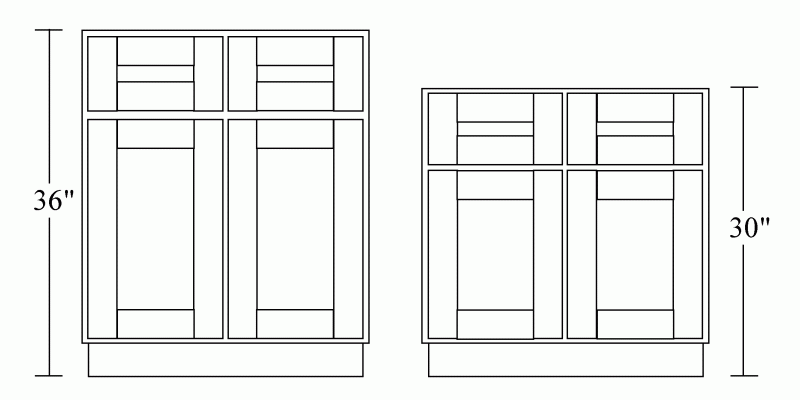
Click here for higher quality, full size image
From contributor B:
To me, neither of the drawings look good. I like the thinner rails on the drawers. Plus, the panel is too narrow to raise. Which brings me to my previous question. What do people do when they encounter panels too narrow to raise? I have just made a solid rail from top to bottom. Any other suggestions? Re-design so the panel is big enough?
From contributor J:
I'm not a fan of the single tall rail because of wood movement issues. If the customer wants a raised panel 5-piece drawer face, then the rails go down to 1-3/4" and when the panels get raised, we run the long edges spaced farther away from the cutter - just enough to maintain at least a 1" tall center flat portion horizontally in the drawer face. The stiles match the doors, and the end cuts on the panels line up vertically with the doors below. We also run a lot of solid slab drawer faces. Whatever the designer/customer wants is the name of the game.
From contributor B:
Contributor J, that makes a lot of sense. Thanks. I have only encountered a couple of these, but that is how I will do it, if it comes up again.
From contributor P:
In short, your idea is a bad design choice.
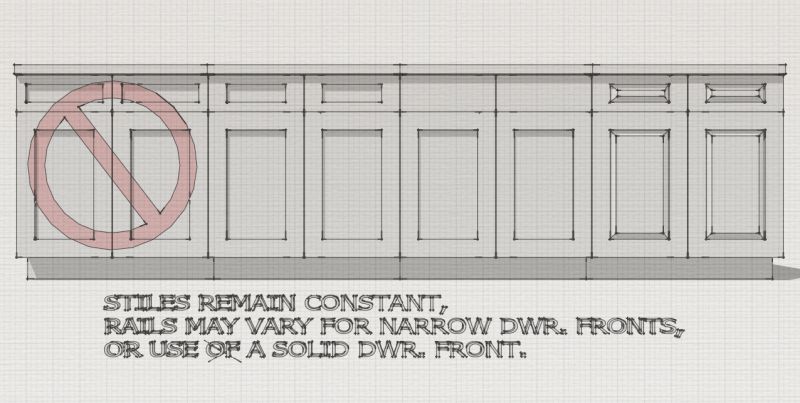
Click here for higher quality, full size image
From contributor D:
Nice, contributor P. Very true, when offered, opting the far right design happens! After designing over a 1000 kitchens, I've put it out there more than once; especially when salespersons don't know the difference. So, I'm beside you - teach good practice.
From contributor O:
Not always true. Christopher Peacock Cabinetry. 100-200k kitchens. Maybe he didn't get the memo, but stiles and rails on his drawers are much thinner than doors below. Whm OHS, same price range, same thing.
From contributor D:
Regarding Whm OHS, I don't have a complete set of his designs, but what I have seen are mostly solid fronts with shaped edges or solid fronts with panel moldings... What do you have that proves he details cabinets like the far right option?
From contributor J:
I'm confused - do you guys agree with contributor P in dismissing the far left as bad design? Other than being overly detailed for some tastes, I don't see a problem with the design on the far right.
From contributor O:
I'm confused too. I thought we were talking about the doors on the far left, the ones with the big red circle thing through them. And the fact that the rails on the drawers always have to line up with the rails on the doors below.
Like I said, that's not always the case. As far as Wm Ohs, he does do both styles you mentioned, but on many other drawers he uses panel moldings with a flat recessed panel and the reveal around the perimeter is a lot narrower than on the door below with the same panel mold, except there he uses a raised panel instead of flat.
From contributor D:
Contributor J, contributor O suggests that the far left design isn't necessarily a lesser design concept, and he's right.
From contributor O:
In response to the original question, and for those who said door and drawer rails have to line up or it's wrong, what I'm saying is some of the top cabinetmakers out there do drawers over doors that have much different size stiles and rails and it looks good. It's all about the proportions. I'm assuming that the questioner's vanity that already has a face frame on it is going to get inset doors. That's why I cited Christopher Peacock cabinets first. He does inset cabinets this way. He also does slab drawers.
From contributor D:
I like inset, beaded or not, and I also enjoyed Christopher Peacock's website. Thanks, I learned a lot!
From contributor O:
Here's a shot taken at the CP showroom.
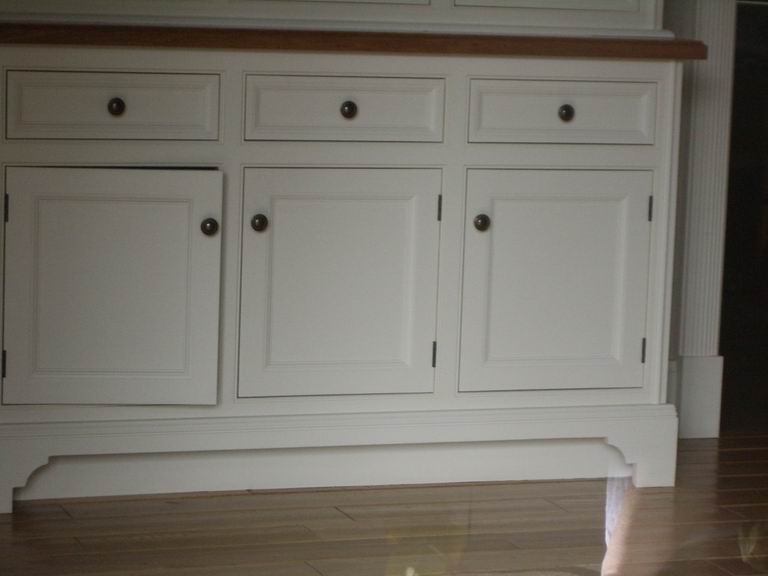
Click here for higher quality, full size image
From contributor U:
I think in the above post, the face frames remain consistent where the stiles/rails for the drawer fronts are a different size and don't impact the design like a change would with a euro cabinet. I use a solid drawer front where the height is too small for a panel and then panel the bottom drawer front. I also go over this with the customer who selects paneled drawer fronts. Or I will make all the fronts larger so panels will work.
From contributor D:
Nice, probably a tinge of blue in the white... classic beaded inset - wow. Each component carefully planned, ornamented, packaged, shipped, and installed - and very difficult to install. Solid brass finial tipped mortise hinges, servo-drive mechanism operating the in-house-built dovetailed drawers. A kitchen designer's dream.
From contributor O:
Here's another shot. His kitchens are shipped primed from the factory. Installed then hand painted (with some special tricks) by a few select crews which he sends to the locations and the customer picks up all their expenses for a week or two. (That's a special trick right there.)
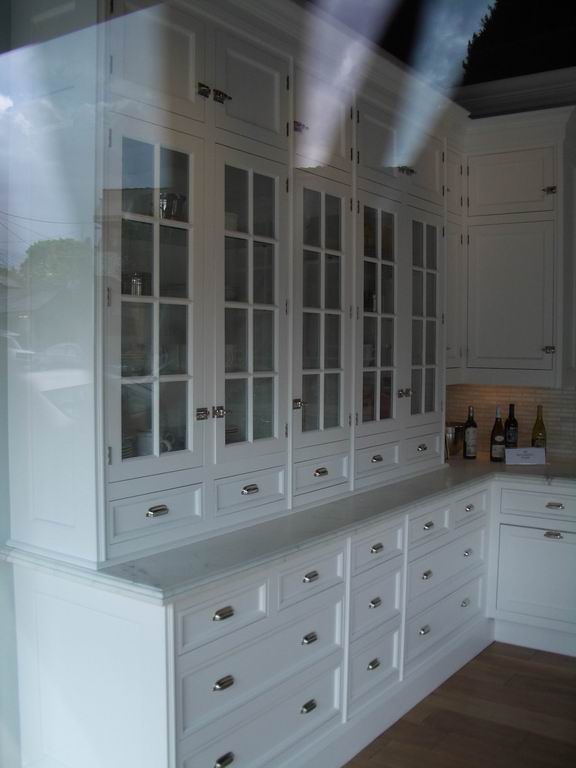
Click here for higher quality, full size image




